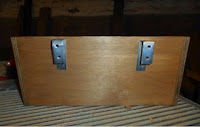This post is about an important piece of research at the University of Gloucester, in partnership with the RSPB, by Sarah Roberts on people's attitudes to having cavities for birds and bats in their houses.
My summary of Sarah's summary (which you can read here) is:
This research aimed to investigate householder attitudes towards integral boxes for birds or bats in order to better inform housing developers and other interested stakeholders involved in establishing or promoting the inclusion of integral boxes into housing developments.
and, the bottom line is ......
Despite 3 out of 142 people having experienced problems, 2 didn't care and just 1 thought it was a bad idea. The other 141 either thought it a good idea (75%) or were neutral (24%).
Thus, should any architect or developer have fears that bird or bat boxes might have a negative effect on their ability to sell houses, they can relax. The evidence is that their houses become more attractive to the buyer.
There is a lot more detail in Sarah's summary
 |
| Starling leaving a Swift brick Photo Sarah Roberts |
My summary of Sarah's summary (which you can read here) is:
This research aimed to investigate householder attitudes towards integral boxes for birds or bats in order to better inform housing developers and other interested stakeholders involved in establishing or promoting the inclusion of integral boxes into housing developments.
and, the bottom line is ......
Despite 3 out of 142 people having experienced problems, 2 didn't care and just 1 thought it was a bad idea. The other 141 either thought it a good idea (75%) or were neutral (24%).
Thus, should any architect or developer have fears that bird or bat boxes might have a negative effect on their ability to sell houses, they can relax. The evidence is that their houses become more attractive to the buyer.
There is a lot more detail in Sarah's summary





